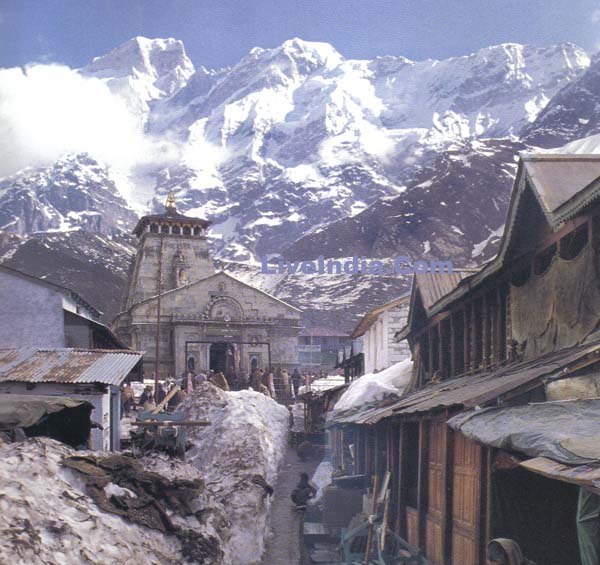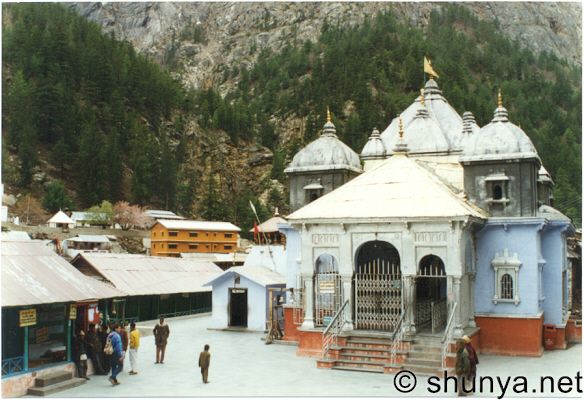The revered spot was once carpeted with wild berries which gave it the name 'Badri Van' meaning 'forest of berries.' Built by Adi Shankaracharaya, the philosopher-saint of the 8th century, the temple has been renovated several times due to damage by avalanches and restored in the 19th century by the royal houses of Scindia & Holkar. The main entrance gate is colourful & imposing popularly known as Singhdwar.
Inside Badrinath Temple:
A flight of steps takes pilgrims to the main gate & then into the Badrinath temple. The temple is divided into three parts - the 'Garbha Griha' or the sanctum sanctorum, the 'Darshan Mandap' where the rituals are conducted and the 'Sabha Mandap' where devotees assemble. The Garbha Griha portion has its canopy covered with a sheet of gold offered by Queen Ahilyabai Holkar. The complex has 15 idols especially attractive is the one-metre high image of lord Badrinath, finely sculpted in black stone. It represents Lord Vishnu seated in a meditative pose called padmasan.Darshan Mandap: Lord Badrinath is sitting meditating in the padmasana (lotus yogic posture). As you look at the Deities, standing to the right side of Badrinarayana is Uddhava. To the far right side are Nara and Narayana. Narada Muni is kneeling in front on the right side and is difficult to see. On the left side are Kubera, the god of wealth, and a silver Ganesh. Garuda is kneeling in front, to the left of Badrinarayana.
Special pujas are also performed on behalf of individuals. Every puja must be preceded by a holy dip in the Tapta Kund. Some of the special morning pujas are Abhishek, Mahaabhishek, Geeta Path. Some special evening pujas are Aarti & Geet Govind. Such pujas are to be booked in advance. The Badrinath temple opens at 0430 hrs & closes at 1300 hrs. Once again it opens at 1600 hrs & closes at 2100 hrs after the divine song Geet Govind. Rawal is the administrator-Pujari of the temple well versed in puja ceremonials & Sanskrit language and is expected to be celibate..
Badri refers to a berry that was said to grow abundantly in the area, and nath refers to Vishnu. Badri is the Sanskrit name for the Indian Jujube trees, which has an edible berry. Some scriptural references also refer to Jujube trees being abundant inBadrinath. Legend has it that Goddess Lakshmi took the form of the berries to protect Lord Vishnu from the harsh climate during his long penance.
Special booking of pujas can be done at Badrinath Mandir Committee by paying some fees. The pooja is organized before the temple is open for general public.
Some festivals celebrated in Badrinath are: Mata Murti ka mela, Krishna Janamashtami and Badri-Kedar utsav.
Badrinath's four subsidiary Badris populary known as Panch Badri include Bhavishya Badri, Yogdhyan Badri, Bridha Badriand Adi Badri. It is popularly believed that with spread of Buddhism, the Buddhists enshrined the statue of Lord Buddha there and during the Hindu renaissance, the statue of Buddha was later restored by Adi Guru as the idol of Vishnu. This possibly explains the deity sitting in Padmasan posture, typical of Buddha icons. However, also according to Hindu mythology, Buddha was considered to be the ninth incarnation of Lord Vishnu.
Kedarnath:-
Amidst the dramatic mountainscapes of the majestic Kedarnath range stands one of the twelve Jyotirlingas of Kedar or Lord Shiva. Lying at an altitude of 3584 m on the head of river Mandakini, the shrine of Kedarnath is amongst the holiest pilgrimages for the Hindus. There are more than 200 shrines dedicated to Lord Shiva in the district itself, the most important one is Kedarnath.
According to legend, the Pandavas after having won over the Kauravas in the Kurukshetra war, felt guilty of having killed their own brothers and sought the blessings of Lord Shiva for redemption. He eluded them repeatedly and while fleeing took refuge at Kedarnath in the form of a bull. On being followed he dived into the ground, leaving his hump on the surface. The remaining portions of Lord Shiva appeared at four other places and are worshipped there as his manifestations. The arms appeared at Tungnath, the face at Rudranath, the belly at Madhmaheshwar and his locks (hair) with head at Kalpeshwar. Kedarnath and the four above mentioned shrines are treated as Panch Kedar.
An imposing sight, standing in the middle of a wide plateau surrounded by lofty snow covered peaks. The present temple, built in 8th century A.D. by Adi Shankaracharya, stands adjacent to the site of an earlier temple built by the Pandavas. The inner walls of the assembly hall are decorated with figures of various deities and scenes from mythology. Outside the temple door, a large statue of the Nandi Bull stands as guard. Dedicated to Lord Shiva, the exquisitely architectured Kedarnath temple is considered to be more than 1000 years old. Built of extremely large, heavy and evenly cut gray slabs of stones, it evokes wonder as to how these heavy slabs had been handled in the earlier days. The temple has a "Garbha Griha" for worship and a Mandap, apt for assemblies of pilgrims and visitors. A conical rock formation inside the temple is worshipped as Lord Shiva in his Sadashiva form...
General Information :-
Area:3 sq km.Season:May to
October.Rainfall:1475
mm.ClothingSummers:Light woollens.
Winters:Very heavy woollens.
Languages:Garhwali, Hindi and English.
Accessibility:-
Air:
Nearest airport is Jolly Grant, Dehradun, 239 km.
Rail:Nearest railway station is Rishikesh, 221 km.
Road: Kedarnath is approachable on foot, 14 km from Gaurikund, which is connected by road with Rishikesh, Kotdwar, Dehradun, Haridwar and other important hill stations of Garhwal and Kumaon hills.
Local Transport: Horses, dandies and ponies are available at Gaurikund for going and carrying luggage to Kedarnath.
Gangotri :-
The shrine of Gangotri is situated at an elevation of 3048 m amidst captivating surroundings. Gangotri is located at a distance of 99 km from Uttarkashi. The temple, constructed by the Gorkha General Amar Singh Thapa, in the 18th century, is situated on the left bank of Bhagirathi. It is visited by lakhs of pilgrims every year. A number of ashrams are located on the other side, some of which provide accommodation facilities to the visitors.
General Information :-
| Altitude | : | 3084 m. |
| Climate | : | Pleasant during day, cold at night. |
| Season | : | April to October. |
| Clothing | : | Heavy woollens throughout the season. |
| Languages | : | Hindi, Garhwali and English. |
Accessibility :-
| Air | : | Nearest airport is Jolly Grant, Dehradun, 17 km from Rishikesh and 265 km from Gangotri. |
| Rail | : | Nearest railhead is at Rishikesh, 248 km away. |
| Road | : | Gangotri is connected by road with Rishikesh, at 265 km away. Garhwal Mandal Vikas Nigam organises different package tours through 2X2 dlx / coach and other cab tours, other bus services are available - Samyukt Rotation Yatayat Vyawastha Samiti connect Gangotri with many centres in the region like Haridwar, Rishikesh, Tehri, Uttarkashi etc.. |
Yamnotri :-
The shrine of Yamunotri, situated at an elevation of about 3,235 m is a point of paramount religious importance for Hindus and an essential pilgrimage. Situated in the direction opposite to Gangotri, the road bifurcates from a place called Dharasu, somewhere between Rishikesh-Uttarkashi and goes on to Yamunotri. The shrine can also be visited via Mussoorie and Barkot.
General Information :-
Altitude:3,235 m.ClimateSummers:Cool during the day and cold at night. Winters:Snow-bound. Touching sub-zero.Clothing Summers:Light woollens. Winters:Very heavy woollens.Languages:Hindi, Garhwali and English.Eating Out:
Only local eating houses (dhabas) are available. Non-vegetarian food and alcoholic drinks are prohibited in Yamunotri.
Accessibility :-
| Air | : | Nearest airport is Jolly Grant, Dehradun. |
| Rail | : | Nearest railhead is at Rishikesh. |
| Road | : | The road to Yamunotri diverts from Dharasu bifurcation point. Important road distances: Hanuman Chatti (13 km), Dharasu (107 km). Tehri (149 km). Hanuman Chatti to Phool Chatti is 5 km by jeep, 3 km Phool Chatti to Janki Chatti on foot and 5 km from Janki Chatti to Yamunotri by trek (8 km trek), the roadhead for Yamunotri is connected by bus services of Samyukt Rotation Yatayat Vyavstha Samiti to Rishikesh, Haridwar and other major centres in the region. Important Road Distances: Rishikesh to Yamunotri 222 km. via Narendranagar 16 km, Chama 46 km, Brahmkhal 15 km, Barkot 40 km, Sayana Chatti 27 km, Hanuman Chatti 6 km, Phool Chatti 5 km, Janki Chatti 3 km and Yamunotri 6 km. |











